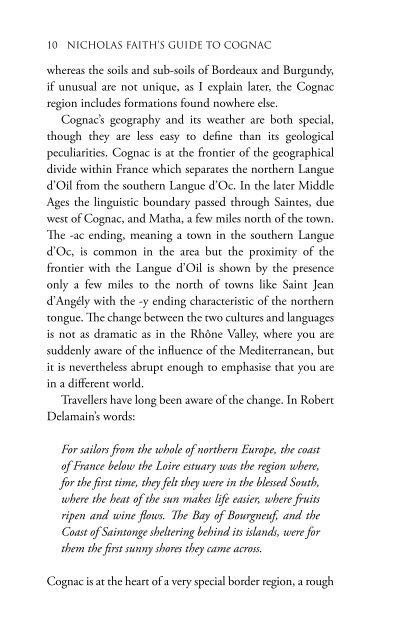You also want an ePaper? Increase the reach of your titles
YUMPU automatically turns print PDFs into web optimized ePapers that Google loves.
whereas the soils and sub-soils of Bordeaux and Burgundy,<br />
if unusual are not unique, as I explain later, the <strong>Cognac</strong><br />
region includes formations found nowhere else.<br />
<strong>Cognac</strong>’s geography and its weather are both special,<br />
though they are less easy to define than its geological<br />
peculiarities. <strong>Cognac</strong> is at the frontier of the geographical<br />
divide within France which separates the northern Langue<br />
d’Oil from the southern Langue d’Oc. In the later Middle<br />
Ages the linguistic boundary passed through Saintes, due<br />
west of <strong>Cognac</strong>, and Matha, a few miles north of the town.<br />
The -ac ending, meaning a town in the southern Langue<br />
d’Oc, is common in the area but the proximity of the<br />
frontier with the Langue d’Oil is shown by the presence<br />
only a few miles to the north of towns like Saint Jean<br />
d’Angély with the -y ending characteristic of the northern<br />
tongue. The change between the two cultures and languages<br />
is not as dramatic as in the Rhône Valley, where you are<br />
suddenly aware of the influence of the Mediterranean, but<br />
it is nevertheless abrupt enough to emphasise that you are<br />
in a different world.<br />
Travellers have long been aware of the change. In Robert<br />
Delamain’s words:<br />
For sailors from the whole of northern Europe, the coast<br />
of France below the Loire estuary was the region where,<br />
for the first time, they felt they were in the blessed South,<br />
where the heat of the sun makes life easier, where fruits<br />
ripen and wine flows. The Bay of Bourgneuf, and the<br />
Coast of Saintonge sheltering behind its islands, were for<br />
them the first sunny shores they came across.<br />
<strong>Cognac</strong> is at the heart of a very special border region, a rough<br />
oblong bounded on the north by the Loire, between the Bay<br />
of Biscay and the mountains of the Massif Central. The whole<br />
area is remarkable for its gentleness. There are no abrupt<br />
slopes, no cliffs, no obvious drama in the landscape which<br />
can appear dull to the uninstructed eye until one begins to<br />
appreciate its subtleties. Its most obvious characteristic is<br />
its weather, like the landscape gentle, temperate, but more<br />
emollient than further north. Everything is softer, lighter,<br />
gentler, and <strong>Cognac</strong> epitomises those qualities.<br />
Naturally the River Charente, which bisects the area, is a<br />
gentle river: ‘the most beautiful stream in all my kingdom,’<br />
said King Henry IV four hundred years ago. They call it<br />
molle, the soft, sweet Charente, which twists and turns<br />
on its leisurely way to the sea. Bordered by willows and<br />
poplars, troubled only by fishermen (and the town’s everenergetic<br />
oarsmen), the Charente is an almost absurdly<br />
picturesque river. The slopes above, like the river itself, are<br />
spacious and gentle. But the Charente is not known as the<br />
rivière de patience for nothing. There is immense variety,<br />
if only because the river changes in width so abruptly. At<br />
times it is so narrow that the trees close in, forming a roof,<br />
their green echoed by their reflections on the water. It is a<br />
complicated stream, with its traps, its numerous weirs, its<br />
treacherous sandbanks, its hidden rocks. Moreover, it is so<br />
low in summer that only flat bottomed boats can float on it<br />
and so high in winter that the waters often reach right up to<br />
the arches of its many bridges. But the Charente is not the<br />
only river providing excellent drainage, there’s the Né, the<br />
border between the two Champagnes, and the Seudre, the<br />
Trèfle and the Seugne.<br />
As you can see from the map on page ix the heart of<br />
the region – where today most of the grapes are grown – is


